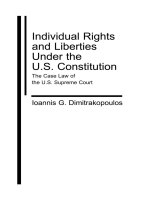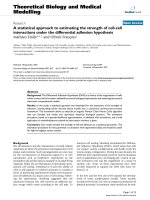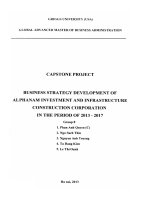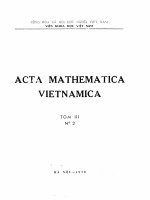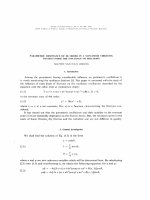Resolution of multiparty construction disputes under the singapore international arbitration legal framework
Bạn đang xem bản rút gọn của tài liệu. Xem và tải ngay bản đầy đủ của tài liệu tại đây (1.51 MB, 270 trang )
RESOLUTION OF MULTIPARTY CONSTRUCTION
DISPUTES UNDER THE SINGAPORE
INTERNATIONAL ARBITRATION LEGAL
FRAMEWORK
DELARAM MEHDIZADEH JAFARI
(LL.M), Islamic Azad University of Central Tehran
A THESIS SUBMITTED
FOR THE DEGREE OF
DOCTOR OF PHILOSOPHY
SCHOOL OF DESIGN AND ENVIRONMENT
DEPARTMENT OF BUILDING
NATIONAL UNIVERSITY OF SINGAPORE
2012
I
II
DEDICATION
To the dearest to my heart, Bruno Piémont, for all his patience, love and inspiration
that helped me finish this long journey.
III
ACKNOWLEDGEMENT
I would like to thank the following persons and institutions:
My supervisor, Associate Professor Philip Chan, for his supervision and assistance
that facilitated the completion of this research.
My supervisor, Dr. Asanga Gunawansa, for his helpful guidance and advice.
Ms. Christabel Toh and Ms. Stephanie Ong Huei Ling in the Department of Building,
for their administrative support.
My friends Mr. and Ms. Nicolas and Linh Payet, for their help with the submission of
this thesis.
National University of Singapore for the funding and assistance during the study.
IV
Table of Contents
SUMMARY X
LIST OF TABLES XII
LIST OF ABBREVIATIONS XIII
TABLE OF CASES XIV
CHAPTER 1- INTRODUCTION 1
1.1 General Statement 1
1.1.1 The legal framework of international arbitration 2
1.1.2 Advantages of arbitration for dealing with construction disputes 4
1.1.3 Limitation of arbitration in dealing with construction disputes 10
1.1.4 Significance of the limitation in international arbitration 14
1.2 Purpose of the Study 18
1.3 Scope of the Study 21
1.4 Research Methodology 24
1.5 Significance of the Study 29
1.6 Limitation of the Study 30
1.7 Organization of the thesis 31
1.8 Definition of the key Terms 32
1.9 Summary 34
CHAPTER 2- LITERATURE REVIEW 36
2.1 General Concerns 36
2.2 Suggestions and solutions 38
V
2.2.1 Using legislative mechanism 38
2.2.1.1 Arguments on Privity of contract 39
2.2.1.2 Arguments on Party autonomy 40
2.2.1.3 Arguments on fairness of arbitration 41
2.2.1.4 Arguments on certainty and finality of the results 42
2.2.1.5 Arguments on confidentiality 42
2.2.1.6 Arguments on efficiency 43
2.2.1.7 Arguments on enforceability 44
2.2.2 Using Institutional Arbitration rules 46
2.2.3 Using Contractual Clauses 50
2.2.3.1 Using identical arbitration clauses 51
2.2.3.2 Selection of the same arbitrator(s) 52
2.2.3.3 Co-operate in the related dispute 53
2.2.3.4 Referring the subcontract dispute to the main-contract arbitration 55
2.2.3.5 Joinder, consolidation and concurrent hearing 57
2.3 Conclusion 59
CHAPTER 3- MULTIPARTY INTERNATIONAL ARBITRATION IN
SINGAPORE – CURRENT AVAILABLE MECHANISMS 62
3.1 Legislation and case Law 62
3.1.1 Legislation 62
3.1.2 Case Law 70
3.2 Institutional Arbitration Rules 78
3.3 Contractual Arrangements 80
3.3.1 Multiparty arbitration mechanisms in the SIA form of main-contract and
subcontract 81
3.3.2 Multiparty arbitration mechanisms in the PSSCOC form of main-
contract and subcontract 83
VI
3.3.3 Multiparty arbitration mechanisms in the REDAS form of contract 84
3.3.4 Multiparty arbitration mechanisms in the FIDIC conditions of contract
and subcontract for construction 85
3.4 Summary 88
CHAPTER 4- LEGISLATIVE APPROACHES TO MULTIPARTY
ARBITRATION ……………………………………………………………………93
4.1 Classification of the existing legislative approaches to multiparty arbitration 90
4.1.1 Express restriction of the tribunal’s power for conduct of multiparty
arbitration 90
4.1.2 Legislative Power of the tribunal to order multiparty arbitration (opt-in
required) 93
4.1.3 Legislative power of the court to order multiparty arbitration (opt-in
required) 96
4.1.4 Legislative power of the court to order multiparty arbitration unless
opted
out 101
4.2 Suitability of the available mechanisms for filling the lacuna in the Singaporean
legislation 106
4.2.1 Expressly forbidding the tribunals and the Courts from the conduct/order
of multiparty arbitration 106
4.2.2 Legislative empowerment of the tribunals to conduct multiparty
arbitration subject to the parties’ opting-in 107
4.2.3 Legislative empowerment of the courts to order multiparty arbitration
subject to the parties’ opting-in 109
4.2.4 Legislative empowerment of the courts to order multiparty arbitration
except if opted
out 109
4.3 Extent of competence of legislation in enabling multiparty international
arbitration…………………………………………………………………………………… 111
4.4 Summary 113
VII
CHAPTER 5- CONTRACTUAL APPROACHES TO MULTIPARTY
ARBITRATION 116
5.1 Direct Contractual mechanisms 116
5.1.1 The deficiency in the selected standard forms 117
5.1.2 The drafting legal issues in addressing multiparty arbitration 123
5.1.2.1 Separate multiparty arbitration clause in the main-contract and
the subcontract 124
5.1.2.1.1 Consent 124
5.1.2.1.2 Dispute 125
5.1.2.1.3 Link 127
5.1.2.1.4 Action 129
5.1.2.1.5 Time 131
5.1.2.1.6 Tiers 134
5.1.2.2 Common multiparty arbitration agreement among the
potentially related parties (the Employer, the main-contractor/s, and the
subcontractor/s) 134
5.2 Indirect contractual mechanisms 136
5.2.1 ICC Rules of Arbitration 137
5.2.2 The ICE Arbitration Procedure and the CIMAR Rules 140
5.2.3 SIAC Rules 141
5.2.4 Arbitration Rules of the S.I.A 143
5.2.5 No Default Applicable Procedural Rules 146
5.2.6 LCIA Arbitration Rules 145
5.2.7 Arbitration rules of the NAI 148
5.2.8 Rules of the ACICA 149
5.2.9 HKIAC Administered Arbitration Rules 149
5.3 Important procedural matters in a multiparty tribunal 152
5.3.1 Involvement in the selection of the members of the tribunal 152
VIII
5.3.2 Division of the costs 156
5.3.3 Inconsistencies in the two agreements 158
5.4 Summary 159
CHAPTER 6 - INSIGHTS FROM STAKEHOLDERS IN THE
CONSTRUCTION INDUSTRY - SUPPLEMENTARY SURVEY…………… 164
6.1 Introduction to the survey and its objective……………………………………… 164
6.2 Survey Issues…………………………………………………………………………… 165
6.3 Studied population…………………………………………………………………… 165
6.4 Sampling method………………………………………………………………………. 166
6.5 Conduct of the survey and the analysis of the results…………………………… 167
6.6 Survey Questions………………………………………………………………………. 167
6.7 Responses and Analysis……………………………………………………………… 168
6.7.1 Introduction of the Respondents…………………………………… 168
6.7.2 Practice of Multiparty Arbitration…………………………………… 171
6.7.3
Legislation…………………………………………………………………. 174
6.7.4 Arbitration Rules…………………………………………………… 179
6.7.5 Contractual Arrangements…………………………………………… 180
6.8 Conclusion…………………………………………………………………………… 186
CHAPTER 7- CONCLUSIONS AND RECOMMENDATIONS 190
7.1 Summary of the findings 190
7.2 Legal Recommendations for the Contracting Parties 195
7.3 Legal Recommendations for the SIAC 198
7.4 Legal Recommendations for the Singaporean Legislature 201
7.5 Areas Recommended for further research 202
IX
BIBLIOGRAPHY 203
TABLE OF STATUTES 211
TABLE OF INTERNATIONAL CONVENTIONS 211
TABLE OF STANDARD FORMS OF CONSTRUCTION CONTRACTS AND
SUB-CONTRACTS 212
TABLE OF INSTITUTIONAL ARBITRATION RULES 213
TABLE OF PUBLISHED INSITUTIONAL ARBITRATION AWARDS 213
APPENDICES 214
Appendix 1 – Contractual clauses 214
Appendix 2 – Institutional rules 230
Appendix 3 – Article V of the New York Convention 236
Appendix 4 – Legislation 237
Appendix 5 – Sample Multiparty Umbrella Agreement 243
Appendix 6 – Survey Questionnaire and Responses 246
X
SUMMARY
This thesis is founded on the fact that multiparty arbitration is difficult to
achieve in the absence of an agreement among all of the disputing parties. This
difficulty is rooted in the contractual nature of arbitration and privity of contracts, and
has traditionally been regarded as a weakness of arbitration as compared to litigation
where the judges enjoy the power of joining the related third parties into a litigation
proceeding if the interests of the third party or at least one of the existing parties are
involved.
The thesis examines the position of Singapore’s International Arbitration
regime in dealing with multiparty construction disputes among the main-contractor,
the sub-contractor and the employer in the circumstances where multiple arbitration
proceedings on the same or related matters potentially result in conflicting decisions
that may be avoided if the disputes are treated in a single multiparty arbitration
proceeding. For this purpose, the mechanisms for joinder or intervention of third
parties or consolidation of related disputes are studied within the legislation, the
institutional arbitration rules and the contractual clauses in the commonly used
standard forms of construction main-contract and sub-contract. The thesis further
compares those mechanisms with their counterparts in four other selected jurisdictions
(England, Hong Kong, Australia, Netherland), in institutional arbitration rules of the
leading arbitration institutions in those countries, and in the internationally used
standard forms of construction main-contract and sub-contract.
The study finds out an international trend in addressing the possibility of
multiparty arbitration and in providing facilitating mechanisms for that purpose.
XI
Examples reflecting this trend include: the legislative granting of power to the courts
or the arbitration tribunals to order or conduct multiparty arbitration, the inclusion of
such power for the arbitrators in the institutional arbitration rules, or certain
contractual arrangements such as an agreement to refer the sub-contract dispute to the
main-contract arbitration in case of related disputes. The various facilitating
mechanisms in the legal channels (legislation, procedural arbitration rules, and
contracts) are examined and assessed in the thesis in order to come up with
suggestions and solutions to be used in Singapore when dealing with the difficulty of
multiparty international arbitration.
The thesis argues that the facilitating mechanisms for multiparty international
arbitration in construction disputes can yet be improved. Suggestions and
recommendations for the Singaporean legislature, the institutional organizations and
the parties of the contracts are put forward. Inspired by the multiparty arbitration
mechanisms that were found outside the Singapore’s International Arbitration
framework, the research finds that the silence in the statutory regime of international
arbitration can be filled; the Singapore International Arbitration Centre’s Arbitration
Rules can include rules that define the tribunal’s power to deal with the circumstances
that require joinder, intervention or consolidation; the main-contractor, the sub-
contractor and the employer should consider entering into multiparty arbitration
agreements that allow the conduct of multiparty arbitration among them in case of
related disputes.
The thesis is therefore an assessment of the legal possibility of multi-party
arbitration under the Singapore’s international arbitration framework, and an attempt
to come up with recommendations and solutions for avoiding the problems that arise
due to the difficulty of multiparty arbitration.
XII
LIST OF TABLES
TABLE 1 MULTIPLE
PROCEEDINGS………………………………………… ………………………12
TABLE 2 OVERVIEW OF THE MECHANISMS WITHIN THE
LEGISLATION OF THE SELECTED JURISDICTIONS IN RESPECT OF THE
POSSIBILITY OF MULTIPARTY ARBITRATION OF RELATED
DISPUTES………………………………………………………………………….105
TABLE 3 OVERVIEW OF THE MECHANISMS WITHIN THE SELECTED
STANDARD FORMS OF CONSTRUCTION CONTRCAT IN RESPECT OF THE
PROBLEMS ARISING OUT OF RELATED
DISPUTES………… 122
TABLE 4 OVERVIEW OF THE MECHANISMS WITHIN THE
INSTITUTIONAL ARBITRATION RULES IN RESPECT OF THE POSSIBILITY
OF JOINDER, INTERVENTION, CONSOLIDATION AND CONCURRENT
HEARING………………………………………………………………………… 151
XIII
LIST OF ABBREVIATIONS
AA Arbitration Act
ACICA Australian Centre for International Commercial
Arbitration
CECA Civil Engineering Contractors Association
CIMAR Construction Industry Model Arbitration Rules
FCEC Federation of Civil Engineering Contractors
FIDIC The International Federation of Consulting Engineers
HKIAC Hong Kong International Arbitration Centre
IAA International Arbitration Act
ICC International Chamber of Commerce
ICE Institution of Civil Engineers
LCIA London Court of International Arbitration
NAI Netherlands Arbitration Institute
PSSCOC Public Sector Standard Conditions of Contract
REDAS Real Estate Developers’ Association of Singapore
UNCITRAL United Nations Commission on International Trade Law
SIA Singapore Institute of Architects
SIAC Singapore International Arbitration Centre
XIV
TABLE OF CASES
Singapore
Abu Dhabi Gas Liquefacation Co Ltd v. Eastern Bechtel Corporation [1982]
(C.A) 2 Lloyd’s Rep 425
AJU v. AJT [2001] SGCA 41
Compagnie European de Creals SA v. Tradax Export S.A., (1986) HC, Q.B.
Com Ct; [1986] 2 Lloyd’s Rep 301
Conocordia Agritrading Pte Ltd v. Cornelder Hoogwerff (Singapore) Pte Ltd
SGHC [2001] 1 SLR 222
Fairmount Development PTE Ltd v. Soh Beng Tee & Co Pte Ltd [2006]
SGHC 189
Go Go Delicay Pte Ltd v. Carona Holdings Pte Ltd and others [2007] SGHC
97
Good Earth Agricultural Co Ltd v. Novus International Pte Ltd [2008] 2 SLR
711
Government of the Republic o the Philippine v. Philippine International Air
Terminal Co.Inc [2006] SGHC 206; [2007] 1 SLR 278
Jiang Haying v. Tan Lim Hui and another Suit [2009] SGHC 42
Insigma Technology Co Ltd v. Alstom Technology Ltd [2009] SGCA 24; 3
SLR 936
Myanma Yaung Chi Oo Co Ltd v. Win Win Nu [2003] SGHC 124
Sobati General Trading LLC v. PT Multistrada Arahsarna [2009] SGHC 245
Soh Beng Tee & Co Pte Ltd v. Fairmount Development Pte Ltd [2007] SGCA
28; [2007] 3 SLR 86
Star Trance Far East Pte Ltd v. Norske-Teck Ltd [1996] C.A 2 SLR 409
Tiong Very Sumito and others v. Antig Investments Pte Ltd [2009] SGHC 41
The “Rainbow Joy” [2005] 3 SLR719 ; [2005] SGCA 36
Rickshaw Investment Ltd v. Nicolai Baron von Uexkull [2007] C.A 1 SLR 377
XV
Yee Hong Pte Ltd v. Tan Chy Andrew (Ho Bee Development Pte Ltd, Third
Party) [2005] SGHC 163
United Kingdom
Dredging and Construction Co Ltd v Delta Civil Engineering Co Ltd [1999]
Queen’s Bench Division 68 Con LR 87
Fox v. P.G. Welfair Ltd [1981] (C.A) 2 Lloyd’s Rep 514
Interbulk v. Aiden Shipping Co Ltd [1982] (C.A) 2 Lloyds Rep 66
Oxford Shipping Co Ltd v Nippon Yusen Kaisha (The Eastern Saga)
[1984]All ER 835
Lafarge Redland Aggregates Ltd v. Shepherd Hill Engineering Ltd [1999]
BLR 252 (C.A)
Lafarge Redland Aggregates Ltd v. Shepherd Hill Engineering Ltd [2000]
1 W.L.R 1621 (H.L) [2000] BLR 385
Levi v. The Anglo-Continental Gold Reefs Co of Rhodesia Ltd [1902] 2
KB 481 at 483, CA
Monmouthshire v Costelloe & Kemple
Compagnie European de Creals SA v. Tradax Export S.A., (1986) HC,
Q.B. Com Ct; [1986] 2 Lloyd’s Rep 301
Taunton-Collins v. Cromie and Others [1964] 1 W.L.R. 633
Hong Kong
Chun Wo Building Ltd & Ors v. China Merchants Tower Co Ltd & Ors (2000)
High Court of the Hong Kong Administrative Region, Court of First Instance,
No.107/1999, date of Judgment 20 Jan 2000, [2000] 2 HKC 255 at para 7
Dickson Construction Co Ltd v. Schindler Lifts (HK) Ltd [1993] 1 HKLR 45
Linfield Ltd v. Brooke Hiller Parker (a firm) & Ors [2003] 2 HKC 624
Miscellaneous Proceedings No.1275 of 1987 in the matter of the Arbitration
Ordinance CAP 341 and in the matter of arbitrations between Shui On
Construction Company Ltd and Moon Yik Company AND between Shui On
Construction Company Ltd and Dah Chong Hong Ltd, in the SupremeCourt of
Hong Kong, High Court, HCMP001275/1987 available at
/>87-40622.html?query=%7e+shui+on+consolidation
XVI
Re Shui On Construction Co.Ltd v. Shindler Lifts (HK) Ltd [1986] HKLR
1177
Shui On (Shui On Construction Co.Ltd v. Moon Yik Co. [1987] HKLR 1224
Australia
Varnsdorf Pty Ltd v. Fletcher Construction Ltd and Another [1998] VSC 206
Melville Homes Pty Ltd v. Prime Ceramics Services Pty Ltd [1991] VSC 2
VR 211
Malaysia
Kumpulan Emas Bhd v. Dato Lim Teng Lew & Anor [2004] HC (Kuala
Lumpur) 2 MLJ 608
1
Chapter 1 - Introduction
1.1. General Statement
Arbitration is a non-court private and binding method of dispute resolution.
1
According to the ICC 2008 Statistical Report, construction and engineering disputes
were the most numerous among the cases registered for arbitration in 2008.
2
Arbitration is the selected method of dispute resolution in almost all standard
construction contracts.
3
Compared to litigation, arbitration has a series of advantages
that particularly makes it suitable for dealing with construction disputes. As an
introduction, the legal framework of arbitration needs to be explained first. After that,
the advantages of arbitration will be briefly reviewed in order to verify the importance
of arbitration as a dispute resolution method in international construction disputes.
The discussion will then be followed by an introduction to the concerns over an
important weakness of arbitration i.e. dealing with multiparty disputes. Unlike in
litigation, arbitrators are unable to join the related third parties into the proceedings.
In the case of multiple arbitration proceedings over the same issues of fact or law,
multiple awards will be issued and there will be the risk of inconsistencies, delays and
high expenses before reaching a final settlement. To get the most out of arbitration
and its advantages, an attempt to overcome this weakness will then be justified.
1
Arbitration is defined as “a method of dispute resolution involving one or more neutral third parties
who are usually agreed by the disputing parties and whose decision is binding.” Black's Law
Dictionary (St.Paul, Minn: Thomas West, 2004), p.112
2
International Court of Arbitration at the International Chamber of Commerce, “ICC 2008 Statistical
Report” (2009) 20:1 ICC Arbitration Bulletin at 13.
3
Examples are the S.I.A Articles and Conditions of Building Contract and the PSSCOC Standard
Conditions of Contract for Construction Works (used in domestic projects) and the FIDIC Conditions
of Contract for Building and Engineering Works Designed by the Employer (used in international
projects) and their parallel forms of subcontract.
2
1.1.1 The legal framework of international arbitration
As a private method of dispute resolution, arbitration is created by the parties’
agreement to arbitrate their prospective or existing disputes. Such an agreement can
be stated as a contractual clause or as a separate contract for arbitration. The
agreement may incorporate arbitration rules of an arbitration institution by reference,
or may confer various powers to the arbitration tribunal. Like other valid and binding
contracts, the binding nature of arbitration is derived from the support of its respective
national legal system. In international arbitration, various national legal systems and
international conventions may be involved for determining the validity and the effect
of the arbitration agreement.
4
The term “governing law of arbitration” is meant to
present a body of rules which sets a standard external to the arbitration agreement,
and the wishes of the parties, for the conduct of arbitration.
5
In each national
jurisdiction, dual or common legislation is adopted to govern domestic and
international arbitration.
6
Through international conventions, a coordination of the
various interacting national laws is sought. Therefore, international arbitration is
governed by three levels of legal regime: First, Contracts; second, respective national
4
These laws include: The national law determining the capacity of the parties to enter into an
arbitration agreement; the law governing the arbitration agreement; the law of the seat of arbitration;
the procedural law chosen to govern arbitration; the law applicable to the substance of the dispute; the
law of any country where provisional remedies or judicial assistance in gathering of evidence is
requested; the law of any country where the recognition and enforcement of the award is sought; the
law of any country where competing judicial proceedings are initiated. See Buhring-Uhle, Ch.,
Arbitration and Mediation in International Business, (The Netherlands: Kluwer Law International,
2006) at 44; Redfern, A. and Hunter, M, Law and Practice of International Commercial Arbitration
(London: Sweet&Maxwell, 2004) at78.
5
Redfern, A. and Hunter, M., ibid, at 79.
6
For example, see English Arbitration Act 1996 that governs both domestic and international
arbitration; and the Singapore Arbitration Act, Cap.10.(2001, R.S. 2002), and The Singapore
International Arbitration Act, Cap. 143 A. (2002) governing domestic arbitration and international
arbitration respectively.
3
legal systems and third, International conventions between states. Considering that the
binding effect of the private contracts and the international conventions is conferred
upon them by the national legal systems, the national legal system gains a central
importance in the legal framework of arbitration.
7
Whereas the parties to disputes may
choose the substantive law of the contract in dispute, the law applicable to the
procedure of arbitration often depends on the national law of the place of conduct of
arbitration
8
; that is to say, the agreement of the parties for the application of
procedural arbitration rules and laws will be effective to the extent permissible by that
law.
9
In Singapore, international arbitration (as defined in section 5 of the IAA) is
automatically governed by the International Arbitration Act unless opted out by the
parties.
10
In the latter case, and in any arbitration that falls out of the governance of
the IAA, the Arbitration Act is applicable.
11
Accordingly, the selection of a national
law contrary to Singapore law to govern the procedure of arbitration is not possible
under Singapore law.
12
Under the IAA, the Model law has the force of law in
Singapore
13
, and the New York Convention is given effect. This means that an award
7
See Buhring-Uhle, Ch., supra note 4 at 42.
8
Redfern, A. and Hunter, M., supra note 4 at 83.
9
Buhring-Uhle, Ch, supra note 4 at 43.
10
Section 5(2) of the Singapore IAA
11
Section 3 of the Singapore AA: “This Act shall apply to any arbitration where the place of arbitration
is Singapore and where part II of the International Arbitration Act (Cap 143 A) does not apply to that
arbitration.”
12
Some national arbitration statutes, allow the selection of other national laws to govern the procedure
of arbitration in their state. For example, see Article 1493 of the French Code of Civil Procedure.
13
Save for chapter VIII of the UNCITRAL Model Law.
4
made in any other country that is a party to the New York Convention, can be
enforced in Singapore in the same manner as a court judgment in Singapore.
14
1.1.2 Advantages of international arbitration for dealing with construction
disputes
Enforceability: Perhaps the most important advantage of international
arbitration over other methods of dispute resolution is the enforceability of arbitration
awards. Enforceability in its wide concept includes three notions: Firstly, the binding
nature of an arbitration award, i.e. it is not only a recommendation (as in mediation),
but a binding decision that the parties have to accept; Secondly, finality of the award,
i.e not being the subject of various appeals in higher tribunals, as is the case with
court judgements; and thirdly the possibility of the direct enforcement of the award
both nationaly and internationally as a result of the New York Convention.
15
Neutrality: One of the important features of major international construction
projects is the involvement of parties from different jurisdictions, with different
cultural approaches and legal systems.
16
Considering the possibility of the parties’
participation in the selection of the tribunal, by reference to arbitration, a dispute is
more likely to be determined by a neutral forum and a neutral tribunal compared to
litigation of the dispute in the home court of one of the parties. Neutrality of an
arbitration tribunal compared to the national courts is an advantage that is more
evident in international arbitration where parties naturally fear the risk of bias of
14
Section 29 of the IAA and Art III of the New York Convention
15
Redfern, A., and Hunter, M., supra note 4 at 23.
16
Jenkins, J. and Stebbings, S., International Construction Arbitration Law, (The Netherlands: Kluwer
Law International, 2006) at 8.
5
foreign courts.
17
In a foreign court, a party may find itself in an unfair situation when
the litigation is conducted in a language other than its own; the cost of translation of
the documents is imposed. The obligation to use lawyers other than those who are
accustomed to their business is another difficulty for foreign parties in litigation that
may in turn influence the neutrality of the tribunal (inherent Bias).
18
Choice of Arbitrator: Disputes arising out of construction contracts are
usually technical. Examples are disputes that arise out of matters such as the
evaluation of the completed works, the due payments, the schedule for completion,
etc. that are not always contractually pre-arranged, but are subjected to the discretion
of the engineer or architect within the progress of the works. Referring such matters to
litigation will require explanation of the nature of construction contracts, industry
stand and the technical construction concepts to the judges. Since arbitration is a
contract, the parties are generally free to select the arbitrator. Freedom in the selection
of the arbitrators allows the parties to refer their technical disputes to experts in the
field that in turn results in more technical awards with fewer flaws. For example, it
may be appropriate that one or more of the members of the arbitration tribunal should
be a civil engineer or someone skilled in the particular technical matters that are at
issue.
19
With the recent development of specialized courts in some countries such as
the Technology and Construction Courts (TCC) in the United Kingdom, courts may
be as technical.
20
However, such specialized courts are not globally widespread.
17
Buhring-Uhle, Ch., supra note 4 at 17; Redfern, A. and Hunter, M., supra note 4 at 22.
18
Redfern, A. and Hunter, M., supra note 4 at 23.
19
ICC International Court of Arbitration, “Introduction to Arbitration”, available at
, last viewed 1.5.2012; Redfern, A. and
Hunter, M., supra note 4 at 196;
20
See Akenhead, Hon.Mr.Justice, “The Benefits of Using Technology and Construction Courts”, PLA
Annual Conference, Keble College, Oxford, 23
rd
March 2012, available at
6
Further, due to the abovementioned major interests of the international parties i.e.
neutrality and enforceability, specialized litigation can be more beneficial for
domestic rather than international arbitration. The choice of arbitrator in international
arbitration frees the parties from referring their case to a national court where the
parties have no influence on the selection of the judge. The influence of the parties in
the selection of the arbitrator may increase their confidence in their selected arbitrator
and create more satisfaction for the parties.
21
Flexibility: Flexibility of arbitration is the reflection of the principle of party
autonomy according to which the parties are free to design the procedure of
arbitration in any way they deem fit and to create tailor made processes to
accommodate the particularities of dispute.
22
This is usually done through the
selection of the applicable law, the language and the venue of arbitration. Complex
disputes are likely to require a higher degree of flexibility in the resolution stage.
Construction projects as amalgams of big-scale, inter-related and sequenced activities
are more likely to give rise to complex disputes that can enjoy the flexibility of
arbitration instead of the strict formalities of litigation in various aspects such as the
location of the proceedings, the depositions, document requests, control of discovery
and the applicable laws.
Speed and Costs: Quick and cheaper resolution of the dispute may become
very important in the construction domain where disputes typically arise out of big
, last retrieved
14.5.2012.
21
See Lew, J.D.M et al, infra note 78 at 222. It should also be noted that the important advantage of
choice of arbitrator can produce unwanted consequences in certain circumstances such as where the
parties refuse to co-operate in the selection of the arbitrator(s) or a party misuses their freedom by
appointing a biased arbitrator. See Lew, J.D.M et al, at 222.
22
Buhring-Uhle, CH., supra note 4 at 174; Redfern, A. and Hunter, M., supra note 4 at 23.
7
scale projects that can be more vulnerable in terms of time and costs. Moreover, high
degree of interrelatedness is a common feature of construction works. Therefore, the
delay caused by a dispute over one part of a construction project is likely to affect the
other parts of the project and result in further time and cost related responsibilities for
the disputing parties and others that may be affected by the delay. Arbitration has
historically been considered as a faster and cheaper method of dispute resolution
compared to litigation.
23
In recent times, some commentators believe that this feature
of arbitration is not certain at all times.
24
The improvements in the speed of litigation
by the allocation of special courts for construction disputes in some countries e.g.
England, and the increase in the various expenses of arbitration such as counsel fees,
costs of venue and administrative fees are the facts that have affected the traditional
time and cost advantages of arbitration. The Queen Mary University’s Arbitration
Survey showed that among the responding corporations, the most significant concern
associated with the use of international arbitration was the expense of arbitration. Yet,
the study concluded that although international arbitration can sometimes be as
expensive as transnational litigation, it represents better value for money.
25
Although it is probably unwise to generalize about what mechanism is faster
and less expensive
26
, it can at least be said that arbitration has the potential of being a
faster and cheaper means of dispute resolution in many occasions if compared to
23
ICC International Court of Arbitration, “Introduction to Arbitration” available at
, last viewed 1.5.2012.
24
Redfern, A. and Hunter, supra note 4 at 24; Buringh Uhl, Ch., supra note 4 at 269; Jenkins, J. and
Stebbings, supra note 16 at 79; Seidenberg, S., “International Arbitration Loses its Grip: Are US
Lawyers to blame?” (2010) 66 ABA Journal 50 available online at
; and Queen
Mary University of London, infra note 47.
25
Infra note 47, Executive Summary, at 2.
26
Born, G.B., International Arbitration and Forum Selection Agreements: Drafting & Enforcing
(Netherlands: Wolters Kluwer Law and Business, 2006) at 7.
8
litigation. More speed and less costs of arbitration can be achieved as a result of the
flexibility feature of arbitration (discussed earlier)
27
. Due to the flexibility feature, the
parties can consciously make an effort to reduce the costs by designing the various
aspects of arbitration e.g. by selection of a cheaper place for arbitration. In addition,
the “finality” of arbitration prevents the award from being followed by a series of
costly appeals to superior courts; as a result, the total costs and time of arbitration is
likely to be less compared to an international litigation that is likely to be subjected to
reviews.
28
Privacy: Privacy of arbitration refers to the private hearing of arbitration only
among the parties of the arbitration agreement.
29
Privacy of arbitration is based on the
principle of ‘privity of contracts’ that is recognized in common law. Arbitration, being
a contract, will only be effective between the contracting parties. An arbitration
agreement does not give any right for non-contracting parties to participate in the
hearing. In Singapore, privity of contracts is recognized in Go Go Delicay Pte Ltd v.
Carona Holdings Pte Ltd and others
30
and Jiang Haying v. Tan Lim Hui and
another Suit
31
. In English law, Oxford Shipping Co Ltd v Nippon Yusen Kaisha (The
Eastern Saga)
32
is an example of recognition of privacy of arbitration where Leggatt
LJ stated:
27
See page 3.
28
Redfern, A. & Hunter, M., supra note 4; Jenkins, J. & Stebbings, S., supra note 16 at 76.
29
Redfern, A. & Hunter, M., supra note 4 at 29.
30
[2007] SGHC 97
31
[2009] SGHC 42
32
[1984]All ER 835
